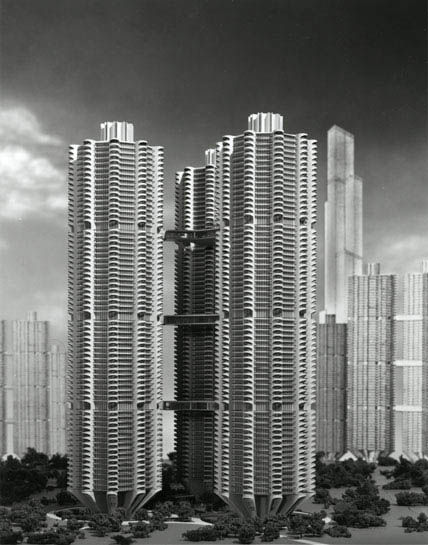04. River City I (9 triads), Chicago, IL. Triad model view, c.1974-1976.
1972-1979.
Originally planned for as many as 20,000 units on the 230 acres, the earliest, fully-developed River City scheme consisted of nine "triads," each of which contained three 80 story towers, connected every 18th floor by a "Community Service Bridge" which provided postal services, shops and a primary school for the nearest 750 families. Unlike Marina City, River City was designed from the beginning to include families with school-aged children. Goldberg felt that, historically, planners had "failed to plan adequately in... high-rise structures for the complexities of family life... juveniles and... community relationships."
As with Marina City, the primary directives behind River City were to increase the population of the inner city and to provide these residents with jobs and cultural opportunities close to home. Recalling the social engineering of the Hilliard Homes, River City was designed with the intent of creating an "instant community... comprised of synergistic entities"*, such as schools, businesses, religious bodies and social clubs. Goldberg noted that as American cities became more pluralistic, many long-standing ethnic and religious communities within these cities fractured and eventually disappeared, leaving a social and cultural void for its residents. He even went so far as to fault himself for failing to create such communities at Marina City. By constructing buildings that foster interaction and communication among its inhabitants, Goldberg hoped to spawn communities within the triads that would generate and sustain what he believed to be the "currency" of any neighborhood: "money, church, food, love, talk and environment."
---------------------------------------------------------------------------------------------------------------------
* Wright and Silverman A Tale of Two Cities, graduate school project, 1988.
"Architecture for Urbanism: Selections from the Bertrand Goldberg Archive," Case 6, Ryerson & Burnham Libraries, November 1, 2011–January 2, 2012
Link to R&B Archives Digital Collections record

